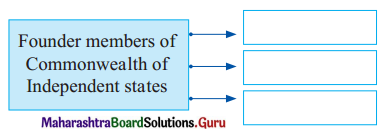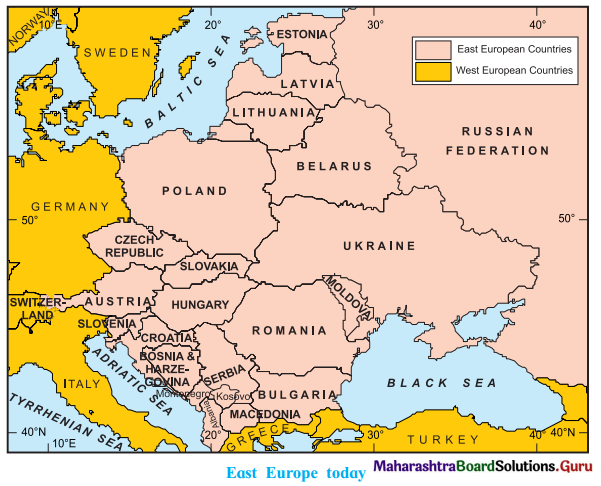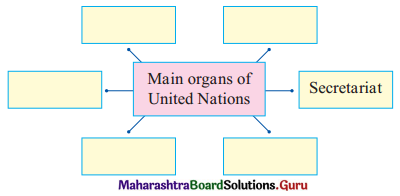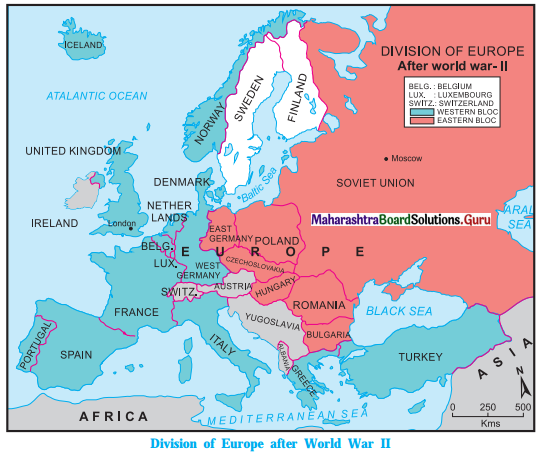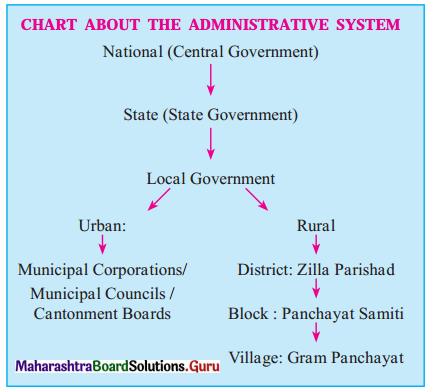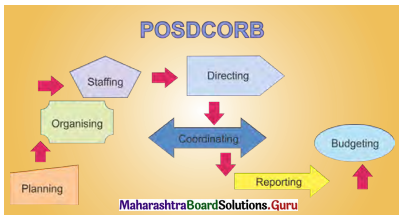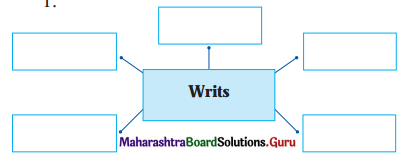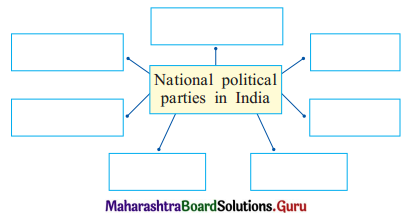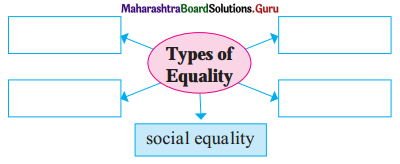Balbharti Maharashtra State Board Class 11 Economics Solutions Chapter 2 Money Textbook Exercise Questions and Answers.
Std 11 Economics Chapter 2 Question Answer Money Maharashtra Board
Class 11 Economics Chapter 2 Money Question Answer Maharashtra Board
Economics Class 11 Chapter 2 Question Answer Maharashtra Board
1. Complete the correlation:
Question 1.
Primary function of money : Medium of exchange : : ___________ : Transfer of value
Answer:
Secondary function of money
Question 2.
___________ : Basis of credit : : Secondary functions of money : Standard of deferred payments.
Answer:
Contingent function of money
Question 3.
Commodity money : Shells : : ___________ : Credit card
Answer:
Plastic money
![]()
Question 4.
Divisibility : Smaller denomination : : ___________ : Easy to carry from one place to another.
Answer:
Portability
Question 5.
Barter system : Goods : : Modern economy : ___________
Answer:
Money
2. Give economic terms:
Question 1.
The act of exchanging goods for goods – ___________
Answer:
Barter System
Question 2.
Provision for making payments in future – ___________
Answer:
Deferred payment
Question 3.
System that makes use of currency for facilitating payments – ___________
Answer:
Digital system
![]()
Question 4.
Credit instrument through which bank deposits are transferable – ___________
Answer:
Cheque/Demand Draft
Question 5.
Monetary value stored and transferred electronically by means of computer hard drive or servers – ___________
Answer:
E-money
Question 6.
Money not accounted for in the bank and not disclosed to the government – ___________
Answer:
Black money
3. Choose the correct option:
Question 1.
Arrange in order of evolution of money.
(a) Metallic money
(b) Animal money
(c) Metallic coins
(d) Commodity money
Options:
1) a, b, c, d
2) b, d, a, c
3) d, c, a, b
4) c, a, b, d
Answer:
2) b, d, a, c
![]()
Question 2.
Arrange in order of Evolution of money.
(a) Plastic money
(b) Electronic money
(c) Paper money
(d) Credit money
Options:
1) b, d, a, c
2) a, b, c, d
3) d, c, b, a
4) c, d, a, b
Answer:
4) c, d, a, b
4. Identify and explain the concepts from the given illustrations:
Question 1.
Vasantsheth provides coal from his shop to farmers in exchange for foodgrains.
Answer:
Barter System.
The barter system refers to the exchange of goods against goods. In the above case, it is a barter exchange as Vasantsheth exchanges coal against food grains.
Question 2.
Babanrao deposits his money in a nationalized bank.
Answer:
Bank Money.
Bank money or credit money refers to cash deposits saved by people. It can be withdrawn or transferred or demanded by means of cheque, draft, etc. In the above case, it is bank money, because Mr. Babanrao deposits his cash into the bank as deposits.
Question 3.
Charu used her debit card to purchase a shirt for her younger brother.
Answer:
Plastic Money.
Plastic money is optional money in the form of Debit cards and Credit cards. In the above case, Charu purchases a shirt with a debit card. Hence, she is using a form of Plastic money.
Question 4.
Malathi purchased a house through an agent. The agent accepted the commission amount in cash but did not issue a receipt to her.
Answer:
Black money.
Money that is received in cash but not accounted for and on which tax is not paid to Government is called Black Money. In the above case, the agent did not issue a receipt to Malathi, hence it will be a case of Black money.
![]()
Question 5.
To prevent misuse/fraudulent use of the national currency, a note ban is imposed on its use at certain times.
Answer:
Demonetization.
Demonetization is a tool to control black money in a country. A note ban is a case of demonetization.
5. State with reasons whether you agree or disagree with the following statements:
Question 1.
There are no difficulties in the barter system.
Answer:
No, I do not agree with the statement.
A barter system is a process of exchange under which people exchange goods and services produced by them with goods and services produced by others. With the progress of civilization, human wants to be multiplied and the barter system of exchange became obsolete. This was because of various inherent limitations. They are as follows:
- Lack of double coincidence of wants: Barter exchange cannot take place unless there is a double coincidence of wants. Under Barter System wants may not always coincide.
- Lack of common measure of value: In the Barter System, there was no common measuring unit of account, so it was difficult to calculate the value of goods to be exchanged.
- The problem of storage: There was the problem of storage under Barter exchange because most of the commodities exchanged were agricultural in nature. Such as rice, wheat, etc. which were perishable.
- The problem of divisibility: There was the problem of divisibility when it was a bulky commodity. E.g. exchange of rice and wheat with the horse was difficult.
- The problem of making deferred payments: Future payment was not possible in the Barter exchange. Borrowing and lending were difficult.
Question 2.
There are many good qualities found in modern currency.
Answer:
Yes, I agree with the statement.
There are many good qualities found in a modern currency like:
- General Acceptability: It must be generally accepted as a medium of exchange.
- Stability: The purchasing power of money should be stable because money serves as a store of value.
- Cognizability: It must be easily recognizable or identifiable. For E.g. Notes of different denominations must be of different sizes, colours, etc. so that they can be easily identified.
- Durability: Money should be durable also i.e. its value should not fluctuate too much.
- Divisibility: Money should be divisible into units of smaller denominations.
- Portability: It should be easy to handle and carry from one place to another.
- Homogeneity: Money of the same denomination should be identical in shape, size, colour, etc.
![]()
Question 3.
Many tasks are accomplished with money.
Answer:
Yes, I do agree with the statement.
Money performs a number of functions in today’s economy. They are as follows:
- Medium of Exchange: It serves as a medium of exchange, i.e. any commodity can be purchased or sold for money.
- The measure of Value: Money helps to compare the price of commodities in the modern economy, which was not possible during the Barter period. Value of commodity can be expressed in different currencies like Rupee in India, Dollar in the U.S.A., etc.
- Standard of deferred payment: Deferred payment means making payment at a future date. This was not possible in a barter economy, because taking loans was easy, but its repayment was difficult as the loan was in form of grains, cattle, etc.
- Store of value: Money made possible the habit of saving for the future. Saving was not possible during the barter economy as commodities started deteriorating after a certain period of time. But with the invention of money, now it can be saved for a longer period.
- Transfer of value: Transfer of money from one person to another and from one place to another place, became possible due to the invention of money.
- Contingent Functions: Besides the above functions of money, there are other functions of money, like
- it helps to measure National Income.
- it forms the basis of credit.
- it imparts liquidity to wealth.
- it helps to estimate macroeconomic variables.
Question 4.
Money can be sent anywhere through electronic means.
Answer:
Yes, I do agree with the statement.
- With the invention of new technologies, like mobile phones, tablets, smart cards, computers, etc, money can be sent anywhere nationally or globally.
- E-money is a monetary value that is stored and transferred as and when desired through various means.
- It is the safest mode of transfer as it is backed and monitored by the Central Bank.
- It is also called a digital wallet.
- Hence, money can be sent anywhere through electronic means.
6. Answer the following questions on the basis of the following information:
Ganesh travelled to the mall by bus. He gave the conductor ₹ 10 coins for the ticket. He purchased many commodities from the mall. At the billing counter, he gave his credit card for payment but the billing clerk informed him that only debit cards were accepted. Since Ganesh had forgotten his debit card at home, he offered to make payment by cash.
Question 1.
Identify the types of money used in the information.
Answer:
Types of money used in the above information are:
- Plastic money – Credit card and Debit card
- Paper money
- Token coin.
Question 2.
Explain any two of them.
Answer:
(a) Paper money: It is a substitute for metallic money. It consists of paper currency which is issued by the Central Bank of the country. Currency notes of higher denominations are issued by the Central Bank i.e. Reserve Bank of India.
![]()
(b) Bank money: It is also called Credit money. It refers to deposits that are in the form of cash saved by the people. Such money can be withdrawn or transferred with the help of instruments like cheques, drafts, etc.
Class 11 Economics Chapter 2 Money Intext Questions and Answers
Find out: [Textbook Page No. 11]
Recent changes introduced by the banks for the safe use of plastic money.
Answer:
Various changes and instructions are given by the banks for the safe use of plastic money:
- Do not save the 16 digit card number using multiple payment gateways.
- On the backside of the card, there is 3 digit number which is an added security feature that protects our card from making fraudulent transactions.
- For safe usage, a One Time Password (OTP) is provided by the bank on a client’s personal registered number (mobile number) to use for each transaction.
- Banks are instructed by RBI to move to chip and pin-based cards and avoid the use of magnetic stripe cards. The chip and pin-based cards create a unique token, every time the card is used. This provides a higher level of security than the magnetic strip.
You Should Know: [Textbook Page No. 11]
Explain the terms legal tender money and non-legal tender money.
Answer:
(i) Legal Tender Money: It is the money that is backed by law and refusal to accept this is punishable by law. It is issued by the Central Bank of the country.
E.g.: Currency note of any denominations like ₹ 5, ₹ 10, ₹ 50, ₹ 100, ₹ 200, ₹ 500, and ₹ 2000.
(ii) Non-Legal Tender Money: It is the money that is generally used by people in final payment but there is no legal compulsion to accept (i.e. no one can force to accept it). It is issued by commercial banks.
E.g. cheques, drafts, bill of exchange, etc.
Find out: [Textbook Page No. 11]
List the various modes of digital transactions.
Answer:
Various modes of digital transactions are Debit cards, Credit cards, Mobile wallets, Internet banking, Digital Payment App (Google pay, Paytm, etc), UPI (United Payments Interface), Mobile Banking, Bank prepaid card, etc.
11th Std Economics Questions And Answers:
- Basic Concepts in Economics Class 11 Economics Questions And Answers
- Money Class 11 Economics Questions And Answers
- Partition Values Class 11 Economics Questions And Answers
- The Economy of Maharashtra Class 11 Economics Questions And Answers
- Rural Development in India Class 11 Economics Questions And Answers
- Population in India Class 11 Economics Questions And Answers
- Unemployment in India Class 11 Economics Questions And Answers
- Poverty in India Class 11 Economics Questions And Answers
- Economic Policy of India Since 1991 Class 11 Economics Questions And Answers
- Economic Planning in India Class 11 Economics Questions And Answers
